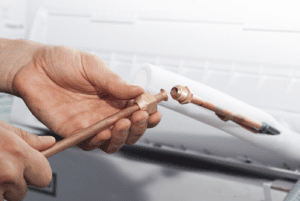The more you learn about the various components in your air conditioner, the better prepared you will be to take care of them. If you do, you can expect to own an efficient system that will be cheaper to run and face a lower risk of breaking down unexpectedly. However, it’s vital that you collect information about even the most innocuous parts of your air conditioner if you want it to stay in first-rate condition and enjoy a long, productive life. One component you may be unfamiliar with is the air conditioner tube. This part is often overlooked by AC owners, but it plays an exceptionally vital role in the proper functioning of your system.
What Does an Air Conditioner Tube Do?

The main function of an air conditioner tube is to regulate the flow of refrigerant throughout your system. Air conditioner tubes are most frequently used to transmit refrigerant to the evaporator coil, without which an AC would not be able to work properly. If you’re becoming a little overwhelmed by all the technical terms though, don’t worry. Just keep reading, and we’ll explain everything you need to know.
First Things First: What is Refrigerant?
The refrigerant is the chemical your air conditioner uses to facilitate temperature changes in your home or office. The refrigerant is normally composed of Freon, which travels through the system in various forms. As it changes states, it either draws heat out of the air or releases heat into the air—effectively changing the temperature indoors.
Below, you’ll find a brief but thorough description of the refrigeration cycle. Once you understand this information, you should be able to see how vital an air conditioner tube’s role truly is.
The Refrigeration Cycle Explained
-
- Refrigerant begins the cycle as a low-pressure gas. As it flows through the HVAC’s compressor, the compressor squeezes it and its pressure increases. Once it enters a high-pressure state, it flows into the condenser.
-
- The condenser causes the high-pressure gas to condense into a liquid form. As this occurs, the refrigerant releases heat. This heat is eventually distributed to the air outside the home.
-
- Next, the refrigerant travels into the expansion valve by way of an air conditioner tube. The tube and valve prevent the refrigerant from entering the evaporator too quickly. The purpose of the expansion valve is also to lower the pressure of the liquid refrigerant by only allowing a small amount through it at one time.
-
- When the low-pressure liquid refrigerant flows through the evaporator, it collects heat from the air and lowers the temperature in your building. As it does so, it vaporizes and turns into a gas all over again.
- The low-pressure gas refrigerant travels into the compressor and repeats the entire process until the building has been cooled to the desired temperature.
As you can see, the air conditioner tube plays a vital role in this process by providing a pathway through which the refrigerant can travel to the expansion valve and other components responsible for the cooling process. As such, it is necessary to ensure that the tubes in your air conditioner are always in excellent condition and free from leaks.
How to Identify a Leaking or Damaged Tube
The section of your air conditioner tubing most likely to sustain damage lies between your indoor and outdoor unit. Often it’s quite lengthy and is only protected from the open air by a layer of insulation. Consequently, any damage to that insulation can prevent your refrigerant from performing as desired, since it can result in cool air being lost to the outside before it has a chance to enter your home.
If you notice that your air conditioner is not working properly—and you have been diligent about changing the filters and having the ducts cleaned on a regular basis—then you may wish to examine your refrigerant lines for damage. If you cannot locate your own lines, it is strongly recommended that you call a licensed professional contractor for help. You’ll need one anyway if your air conditioner tube is damaged, since only professionals should ever handle refrigerant. Remember: refrigerant is a chemical, and it can cause health risks if you are exposed to it in the wrong way. Make sure you entrust that job to a pro who will take the necessary precautions to ensure that it’s done safely.
Take Care of Your Air Conditioner Tube, and it Will Take Care of You
The air conditioner tube that carries refrigerant throughout your system is easy to miss or neglect, but that doesn’t mean it isn’t important. In fact, without it, you’d have a hard time staying cool at all! Use this guide to make sure you are always giving your tube the TLC it deserves, and that you’ll be able to stay comfortable all summer.
Check with us here at Valley Comfort Heating and Air, our customers love our attention to detail and our friendly, affordable service. (707) 539-4533

